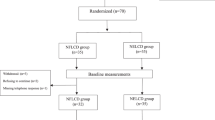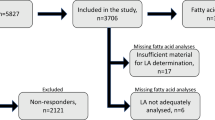Abstract
Objective: To investigate the effects of increased alpha-linolenic acid (ALA)-intake on intima–media thickness (IMT), oxidized low-density lipoprotein (LDL) antibodies, soluble intercellular adhesion molecule-1 (sICAM-1), C-reactive protein (CRP), and interleukins 6 and 10.
Design: Randomized double-blind placebo-controlled trial.
Subjects: Moderately hypercholesterolaemic men and women (55±10 y) with two other cardiovascular risk factors (n=103).
Intervention: Participants were assigned to a margarine enriched with ALA (fatty acid composition 46% LA, 15% ALA) or linoleic acid (LA) (58% LA, 0.3% ALA) for 2 y.
Results: Dietary ALA intake was 2.3 en% among ALA users, and 0.4 en% among LA users. The 2-y progression rate of the mean carotid IMT (ALA and LA: +0.05 mm) and femoral IMT (ALA:+0.05 mm; LA:+0.04 mm) was similar, when adjusted for confounding variables. After 1 and 2 y, ALA users had a lower CRP level than LA users (net differences −0.53 and −0.56 mg/l, respectively, P<0.05). No significant effects were observed in oxidized LDL antibodies, and levels of sICAM-1, interleukins 6 and 10.
Conclusions: A six-fold increased ALA intake lowers CRP, when compared to a control diet high in LA. The present study found no effects on markers for atherosclerosis.
Sponsorship: The Dutch ‘Praeventiefonds’.
This is a preview of subscription content, access via your institution
Access options
Subscribe to this journal
Receive 12 print issues and online access
$259.00 per year
only $21.58 per issue
Buy this article
- Purchase on Springer Link
- Instant access to full article PDF
Prices may be subject to local taxes which are calculated during checkout
Similar content being viewed by others
References
Bemelmans WJE, Muskiet FAJ, Feskens EJM, Vries de JHM, Broer J, May JF & Meyboom-de Jong B (2000): Associations of alpha-linolenic acid and linoleic acid with risk factors for coronary heart disease. Eur. J. Clin. Nutr. 54, 865–871.
Bemelmans WJE, Broer J, Feskens EJM, Smit AJ, Muskiet FAJ, Lefrandt JF, Bom VJJ May JF & Meyboom-de Jong B (2002): Effect of an increased intake of alpha-linolenic acid and group nutritional education on cardiovascular risk factors: the Mediterranean Alpha-linolenic Enriched Groningen Dietary Intervention (MARGARIN). Am. J. Clin. Nutr. 75, 221–227.
Berry EM (2001): Are diets high in omega-6 polyunsaturated fatty acids unhealthy? Eur. Heart. J. 3 (Suppl D), 37–41.
De Caterina R & Basta G (2001): n-3 Fatty acids and the inflammatory response–biological background. Eur. Heart J. 3 (Suppl D), 42–49.
Endres S (1996): n-3 polyunsaturated fatty acids and human cytokine synthesis. Lipids 31 (Suppl), 239–242.
Freese R, Mutanen V, Valstra LM & Salminen I (1994): Comparison of the effects of two diets rich in monounsaturated fatty acids differing in their linoleic/alpha-linolenic acid ratio on platelet aggregation. Thromb. Haemost. 71, 73–77.
Gabay C & Kushner I (1999): Acute-phase proteins and other systemic responses to inflammation. N. Engl. J. Med. 340, 448–454.
Glass CK & Witztum JL (2001): Atherosclerosis. The road ahead. Cell 104, 503–516.
de Groot E, Zwinderman AH, van der Steen AFW, Ackerstaff RGA, van Montauban Swijndregt AD, Bom N, Lie KI & Bruschke AVG (1998): Variance components analysis of carotid and femoral intima–media thickness measurements. Ultrasound Med. Biol. 24, 825–832.
Hennig B, Meerarani P, Ramadass P, Watkins BA & Toborek M (2000): Fatty acid-mediated activation of vascular endothelial cells. Metabolism 49, 1006–1013.
Libby P (2002): Inflammation in atherosclerosis. Nature 420, 868–874.
de Lorgeril M, Renaud S, Mamelle N, Salen P, Martin JL, Monjaud I, Guidollet J, Touboul P & Delaye J (1994): Mediterranean alpha-linolenic acid-rich diet in secondary prevention of coronary heart disease. Lancet 343, 1454–1459.
Ma J, Folsom AR, Lewis L & Eckfeldt JH (1997): Relation of plasma phospholipid and cholesterol ester fatty acid composition to carotid artery intima–media thickness: the Atherosclerosis Risk in Communities (ARIC) study. Am. J. Clin. Nutr. 65, 551–559.
Mantzioris E, Cleland LG, Gibson RA, Neumann MA, Demasi M & James MJ (2000): Biochemical effects of a diet containing foods enriched with n-3 fatty acids. Am. J. Clin. Nutr. 72, 42–48.
Marchioli R & on behalf of the GISSI-Prevenzione investigators (2001): Treatment with n-3 polyunsaturated fatty acids after myocardial infarction: results of GISSI-Prevenzione Trial. Eur. Heart. J. 3 (Suppl D), 85–97.
National Cholesterol Education Program (2001): Executive summary of the Third Report of the National Cholesterol Education Program (NCEP) Expert Panel on detection, evaluation, and treatment of high blood cholesterol in Adults (Adult Treatment Panel III). JAMA 285, 2486–2497.
Pakala R, Pakala R, Sheng WL & Benedict CR (1999): Eicosapentaenoic acid and docosahexaenoic acid block serotonin-induced smooth muscle cell proliferation. Arterioscler. Thromb. Vasc. Biol. 19, 2316–2322.
Rallidis LS, Paschos G, Liakos GK, Velissaridou H, Anastasiadis G & Zampelas A (2003): Dietary α-linolenic acid decreases C-reactive protein, serum amyloid A and interleukin-6 in dyslipidaemic patients. Atherosclerosis 167, 237–242.
Ridker PM (2003): Clinical application of C-reactive Protein for cardiovascular disease detection and prevention. Circulation 107, 363–369.
Ridker PM, Buring JE, Cook NR & Rifai N (2003): C-reactive protein, the metabolic syndrome, and risk of incident cardiovascular events. An 8-year follow-up of 14.719 initially healthy American women. Circulation 107, 391–397.
Ross R (1999): Atherosclerosis— an inflammatory disease. N. Engl. J. Med. 340, 115–126.
Sanders TA (2000): Polyunsaturated fatty acids in the food chain in Europe. Am. J. Clin. Nutr. 71 (Suppl 1), 176–178.
Sanderson P, Finnegan YE, Williams CM, Calder PC, Burdge GC, Wootton SA, Griffin BA, Millward DJ, Pegge NC & Bemelmans WJE (2002): UK Food Standards Agency alpha-linolenic acid workshop report. Br. J. Nutr. 88, 573–579.
von Schacky C (2000): n-3 Fatty acids and the prevention of coronary atherosclerosis. Am. J. Clin. Nutr. 71 (Suppl), 224–227.
Schaefer J (1997): Effects of dietary fatty acids on lipoproteins and cardiovascular disease risk: summary. Am. J. Clin. Nutr. 65 (Suppl 1), 1655–1656.
Schmidt EB, Kristensen SB, De Caterina R & Illingworth DR (1993): The effects of n-3 fatty acids on plasma lipids and lipoproteins and other cardiovascular risk factors in patients with hyperlipidemia. Atherosclerosis 103, 107–121.
Swets BP, Brouwer DA & Cohen Tervaert JW (2001): Patients with systemic vasculitis have increased levels of autoantibodies against oxidized LDL. Clin. Exp. Immunol. 124, 163–167.
Ubels FL, Terpstra WF & Smit AJ (1999): Carotid intima–media thickness: influence of drug treatment and clinical implications. Neth. J. Med. 55, 188–195.
Watts GF, Lewis B, Jackson P, Burke V, Lewis ES, Brunt JN & Coltart DJ (1995): Relationships between nutrient intake and progression/regression of coronary atherosclerosis as assessed by serial quantitative angiography. Can. J. Cardiol. 11 (Suppl G), 110–114.
Wolkerstorfer A, Laan MP, Savelkoul HFJ, Neijens HJ, Mulder PG, Oudesluijs-Murphy AM, Sukhai RN & Oranje AP (1998): Soluble E-selectin, other markers of inflammation and disease severity in children with atopic dermatitis. Br. J. Dermatol. 138, 431–435.
Acknowledgements
The present research was funded by the Dutch ‘Praeventiefonds, Grant No. 28-2757. We thank Unilever Research, Vlaardingen, The Netherlands, for production and storage of the margarines, The St Lucas Hospital in Winschoten for logistic support, Marian Bruin, Margreet Teune-Weessies, and Anne van Gessel for assessment of the IMT, and Jan Damoiseaux, from the University Hospital Maastricht, for valuable comments. Finally, Peter Heymans, Ruud Theunissen, and Roel Brandts are acknowledged for their technical support.
Author information
Authors and Affiliations
Contributions
Guarantor: B Meyboom-de Jong.
Contributors: All investigators contributed to the writing and editing of the manuscript. M-dJ supervised the MARGARIN project and is the guarantor. JB, JFM, AJS, JDL, and WJEB contributed to the design and implementation. EJMF contributed with nutritional expertise and JWCT and PvH with their immunological medical expertise.
Corresponding author
Rights and permissions
About this article
Cite this article
Bemelmans, W., Lefrandt, J., Feskens, E. et al. Increased α-linolenic acid intake lowers C-reactive protein, but has no effect on markers of atherosclerosis. Eur J Clin Nutr 58, 1083–1089 (2004). https://doi.org/10.1038/sj.ejcn.1601938
Received:
Revised:
Accepted:
Published:
Issue Date:
DOI: https://doi.org/10.1038/sj.ejcn.1601938
Keywords
This article is cited by
-
Long-term effects of increasing omega-3, omega-6 and total polyunsaturated fats on inflammatory bowel disease and markers of inflammation: a systematic review and meta-analysis of randomized controlled trials
European Journal of Nutrition (2021)
-
Muscle protein breakdown is impaired during immobilization compared to during a subsequent retraining period in older men: no effect of anti-inflammatory medication
Pflügers Archiv - European Journal of Physiology (2020)
-
Effect of conjugated linoleic acid on blood inflammatory markers: a systematic review and meta-analysis on randomized controlled trials
European Journal of Clinical Nutrition (2018)
-
Effect of dietary alpha-linolenic acid on blood inflammatory markers: a systematic review and meta-analysis of randomized controlled trials
European Journal of Nutrition (2018)
-
Unsaturated Fatty Acids Improve Atherosclerosis Markers in Obese and Overweight Non-diabetic Elderly Patients
Obesity Surgery (2017)



